The Red Backgrounds of Wall Paintings from Isturgi and Cástulo (Jaen, Spain): A Multi-Technique Approach to Understanding and Improving Their State of Conservation
Abstract
:1. Introduction
2. Materials and Methods
2.1. Archeological Site of Cástulo
2.2. Iberian–Roman Villa of Isturgi
2.3. Sample Collection
2.4. Characterization of the Samples
2.4.1. Stereoscopic Microscopy
2.4.2. Optical Microscopy
2.4.3. Scanning Electron Microscopy (SEM)
2.4.4. The Fourier Transform Infrared (FTIR)
2.4.5. X-Ray Photoelectron Spectroscopy (XPS)
3. Results and Discussion
3.1. Analysis of the Techniques Used in the Roman Mural Paintings
3.2. Contextualization of Roman Red Pigments
3.3. Characterization Results
4. Conclusions
Author Contributions
Funding
Data Availability Statement
Acknowledgments
Conflicts of Interest
References
- Mora, P.; Mora, L.; Philippot, P. La Conservazione Delle Pitture Murali, 1st ed.; Editrice Compositori: Bologna, Italy, 2001. [Google Scholar]
- Guiral Pelegrín, C.; Iñiguez Berrozpe, L.M.; Carrillo, A.M. La domus de la calle Añón de Caesar Augusta (Zaragoza) y el programa decorativo del triclinium. Lucentum 2019, XXXVIII, 215–241. [Google Scholar] [CrossRef]
- Abad Casal, I. Aspectos técnicos de la pintura mural romana. Lucentum 1982, I, 135–171. [Google Scholar] [CrossRef]
- Guglielmi, V.; Comite, V.; Andreoli, M.; Demartin, F.; Lombardi, C.A.; Fermo, P. Pigments on Roman Wall Painting and Stucco Fragments from the Monte d’Oro Area (Rome): A Multi-Technique Approach. Appl. Sci. 2020, 10, 7121. [Google Scholar] [CrossRef]
- Fantoni, R.; Lazic, V.; Colao, F.; Almaviva, S.; Puiu, A. Red color characterization in several Roman frescos and paintings by in situ and remote LIBS, LIF and Raman Spectroscopies. Ge-Conservacion 2022, 21, 257–269. [Google Scholar] [CrossRef]
- Gutman, M.; Zupanek, B.; Kikelj, M.L.; Kramar, S. Wall Paintings from the Roman Emona (Ljubljana, Slovenia): Characterization of Mortar Layers and Pigments. Archaeometry 2015, 58, 297–314. [Google Scholar] [CrossRef]
- Gliozzo, E.; Cavari, F.; Damiani, D.; Memmi, I. Pigments and plasters from the roman settlement of Thamusida (Rabat, Morocco). Archaeometry 2011, 54, 278–293. [Google Scholar] [CrossRef]
- Nuevo, M.; Sánchez, A.M.; Ojeda, M.; Millán, S.G. Spectroscopic analysis of decorated vestiges found in the Roman Theatre of Medellín, Badajoz, Spain. Microchem. J. 2016, 124, 675–681. [Google Scholar] [CrossRef]
- Cortea, I.M.; Ghervase, L.; Țentea, O.; Pârău, A.C.; Radvan, R. First Analytical Study on Second-Century Wall Paintings from Ulpia Traiana Sarmizegetusa: Insights on the Materials and Painting Technique. Int. J. Arch. Herit. 2020, 14, 751–761. [Google Scholar] [CrossRef]
- Sáez-Hernández, R.; Antela, K.U.; Gallello, G.; Cervera, M.L.; Mauri-Aucejo, A.R. A smartphone-based innovative approach to discriminate red pigments in roman frescoes mock-ups. J. Cult. Herit. 2022, 58, 156–166. [Google Scholar] [CrossRef]
- Lanzón, M.; Madrid-Balanza, M.J.; Martínez-Peris, I.; García-Vera, V.E.; Navarro-Moreno, D. Roman wall paintings from the Roman Forum district of Carthago Nova: Characterisation of mortars and pigments. Constr. Build. Mater. 2023, 408, 133543. [Google Scholar] [CrossRef]
- Mazzocchin, G.; Agnoli, F.; Colpo, I. Analysis of pigments from Roman wall paintings found in Vicenza. Talanta 2003, 61, 565–572. [Google Scholar] [CrossRef]
- Pérez-Diez, S.; Larrañaga, A.; Madariaga, J.M.; Maguregui, M. Unraveling the role of the thermal and laser impacts on the blackening of cinnabar in the mural paintings of Pompeii. Eur. Phys. J. Plus 2022, 137, 1184. [Google Scholar] [CrossRef]
- Coccato, A.; Mazzoleni, P.; Spinola, G.; Barone, G. Two centuries of painted plasters from the Lateran suburban villa (Rome): Investigating supply routes and manufacturing of pigments. J. Cult. Herit. 2021, 48, 171–185. [Google Scholar] [CrossRef]
- Aliatis, I.; Bersani, D.; Campani, E.; Casoli, A.; Lottici, P.P.; Mantovan, S.; Marino, I. Pigments used in Roman wall paintings in the Vesuvian area. J. Raman Spectrosc. 2010, 41, 1537–1542. [Google Scholar] [CrossRef]
- Becker, H. Pigment nomenclature in the ancient Near East, Greece, and Rome. Archaeol. Anthr. Sci. 2021, 14, 20. [Google Scholar] [CrossRef]
- Jorge-Villar, S.E.; Edwards, H.G.M. Green and blue pigments in Roman wall paintings: A challenge for Raman spectroscopy. J. Raman Spectrosc. 2021, 52, 2190–2203. [Google Scholar] [CrossRef]
- Calabria Salvador, I.; Zaldibea Muñoz, M.A. Estudio de las pinturas murales de la sala del Mosaico de los Amores de la ciudad íbero-romana de Cástulo. Ge-Conservacion 2019, 16, 45–61. [Google Scholar] [CrossRef]
- López Martínez, T.; López Cruz, O.; García Bueno, A.; Calero-Castillo, A.I.; Medina Flórez, V.J. Las pinturas murales de Castulo. Primeras aportaciones a la caracterización de materiales y técnicas de ejecución. Lucentum 2016, 155–170. [Google Scholar] [CrossRef]
- Castro López, M. Avatares constructivos de la sala del mosaico de los Amores. In Siete Esquinas; 2014; pp. 127–128. ISSN 2171-8962. Available online: https://dialnet.unirioja.es/servlet/articulo?codigo=4700625 (accessed on 5 November 2024).
- Fernández García, M.I.; Ruiz Montes, P.; Peinado Espinosa, M.V. El Proyecto Isturgi: Reformularse o morir. Boletín Inst. Estud. Giennenses 2008, 198, 173–188. [Google Scholar]
- Jiménez-Desmond, D.; Pozo-Antonio, J.; Arizzi, A. The fresco wall painting techniques in the Mediterranean area from Antiquity to the present: A review. J. Cult. Herit. 2024, 66, 166–186. [Google Scholar] [CrossRef]
- Carrillo, A.M. La pintura Romana en España: Estado de la cuestión. Anu. Dep. Hist. Y Teoría Arte 1992, 4, 9–22. [Google Scholar] [CrossRef]
- Urosevic, M.; Jiménez-Desmond, D.; Arizzi, A.; Pozo-Antonio, J.; Prieto, C.M.; Oblitas, M.V. Analysis of pigments and mortars from the wall paintings of the Roman archaeological site of Las Dunas (San Pedro de Alcántara, Malaga S Spain). J. Archaeol. Sci. Rep. 2023, 52. [Google Scholar] [CrossRef]
- Crupi, V.; Fazio, B.; Fiocco, G.; Galli, G.; La Russa, M.F.; Licchelli, M.; Majolino, D.; Malagodi, M.; Ricca, M.; Ruffolo, S.A.; et al. Multi-analytical study of Roman frescoes from Villa dei Quintili (Rome, Italy). J. Archaeol. Sci. Rep. 2018, 21, 422–432. [Google Scholar] [CrossRef]
- Barnett, J.; Miller, S.; Pearce, E. Colour and art: A brief history of pigments. Opt. Laser Technol. 2006, 38, 445–453. [Google Scholar] [CrossRef]
- Gliozzo, E. Pigments—Mercury-based red (cinnabar-vermilion) and white (calomel) and their degradation products. Archaeol. Anthr. Sci. 2021, 13, 210. [Google Scholar] [CrossRef]
- Zarzalejo Prieto, M. Pigmento, metal líquido y veneno. Campos de estudio sobre el cinabrio-mercurio en el mundo romano. In Minería y Metalurgia Históricas En El Sudoeste Europeo. Geología. Minería y Sociedad; SEDPGYM: Madrid Spain, 2022; pp. 3–20. [Google Scholar]
- Guiral Pelegrín, C.; Iñiguez Berrozpe, L.M. El cinabrio en la pintura romana de Hispania. In El “Oro Rojo” En La Antigüedad: Perspectivas de Investigación Sobre Los Usos y Aplicaciones Del Cinabrio Entre La Prehistoria y El Fin Del Mundo Antiguo; UNED—Universidad Nacional de Educación a Distancia: Madrid, Spain, 2020; pp. 337–372. [Google Scholar]
- Cerrato, E.J.; Cosano, D.; Esquivel, D.; Jiménez-Sanchidrián, C.; Ruiz, J.R. Spectroscopic analysis of pigments in a wall painting from a high Roman Empire building in Córdoba (Spain) and identification of the application technique. Microchem. J. 2021, 168, 106444. [Google Scholar] [CrossRef]
- Gliozzo, E.; Ionescu, C. Pigments—Lead-based whites, reds, yellows and oranges and their alteration phases. Archaeol. Anthr. Sci. 2021, 14, 17. [Google Scholar] [CrossRef]
- Íñiguez Berrozpe, L. Metodología para el estudio de la pintura mural romana: El conjunto de las musas de Bilbilis. Bordeaux: Ausonius Éditions, collection PrimaLun@, 18. Salduie 2023, 23, 143–145. [Google Scholar] [CrossRef]
- Mateos, L.D.; Cosano, D.; Mora, M.; Muñiz, I.; Carmona, R.; Jiménez-Sanchidrián, C.; Ruiz, J.R. Raman microspectroscopic analysis of decorative pigments from the Roman villa of El Ruedo (Almedinilla, Spain). Spectrochim. Acta Part A Mol. Biomol. Spectrosc. 2015, 151, 16–21. [Google Scholar] [CrossRef]
- Cerrato, E.J.; Cosano, D.; Esquivel, D.; Jiménez-Sanchidrián, C.; Ruiz, J.R. A multi-analytical study of funerary wall paintings in the Roman necropolis of Camino Viejo de Almodóvar (Córdoba, Spain). Eur. Phys. J. Plus 2020, 135, 889. [Google Scholar] [CrossRef]
- Garcia Bueno, A.; Adroher Auroux, A.; López Pertíñez, M.C.; Medina Flórez, V.J. Estudio de materiales y técnica de ejecución de los restos de pintura mural romana hallados en una excavación arqueológica de Guadix (Granada). Espac. Tiempo Forma. Ser. I Prehist. Arqueol. 2000, 13. [Google Scholar] [CrossRef]
- Íñiguez Berrozpe, L.; Guiral Pelegrín, C.; Sáenz Preciado, J.C.; Martín-Bueno, M. La pintura mural romana en Bilbilis: El “Proyecto Pictor”. Actas Del X Encuentro De Estud. Bilbilitanos 2020, 2, 433–443. [Google Scholar]
- Giacomin, C.E.; Holm, T.; Mérida, W. CaCO3 growth in conditions used for direct air capture. Powder Technol. 2020, 370, 39–47. [Google Scholar] [CrossRef]
- Gavioli, L.M.; Mármol, G.; Lima, C.G.; Teixeira, R.S.; Rossignolo, J.A. Comparative performance of M-S-H cement vs. portland cement in fiber cement incorporating bamboo leaf ash and cellulosic fibers. J. Build. Eng. 2024, 91, 109644. [Google Scholar] [CrossRef]
- Duran, A.; López-Montes, A.; Castaing, J.; Espejo, T. Analysis of a royal 15th century illuminated parchment using a portable XRF–XRD system and micro-invasive techniques. J. Archaeol. Sci. 2014, 45, 52–58. [Google Scholar] [CrossRef]
- Aze, S.; Vallet, J.-M.; Baronnet, A.; Grauby, O. The fading of red lead pigment in wall paintings: Tracking the physico-chemical transformations by means of complementary micro-analysis techniques. Eur. J. Miner. 2006, 18, 835–843. [Google Scholar] [CrossRef]
- Miliani, C.; Rosi, F.; Daveri, A.; Brunetti, B.G. Reflection infrared spectroscopy for the non-invasive in situ study of artists’ pigments. Appl. Phys. A 2012, 106, 295–307. [Google Scholar] [CrossRef]
- Volpi, F.; Vagnini, M.; Vivani, R.; Malagodi, M.; Fiocco, G. Non-invasive identification of red and yellow oxide and sulfide pigments in wall-paintings with portable ER-FTIR spectroscopy. J. Cult. Herit. 2023, 63, 158–168. [Google Scholar] [CrossRef]
- Vondrášek, R.; Kuzmann, E.; Pechoušek, J.; Heger, V.; Skuratov, V.; Stichleutner, S.; Machala, L.; Kouřil, L.; Krupa, L. Powder hematite transformation induced by swift heavy ion irradiation with fluence threshold observation. Radiat. Phys. Chem. 2024, 224, 111998. [Google Scholar] [CrossRef]
- Liu, J.; Wang, S.; Yang, Z.; Dai, C.; Feng, G.; Wu, B.; Li, W.; Shu, L.; Elouarzaki, K.; Hu, X.; et al. Phase shuttling-enhanced electrochemical ozone production. EES Catal. 2023, 1, 301–311. [Google Scholar] [CrossRef]
- Rao, Y.D.; Venkatramaiah, N.; Sekhar, A.V.; Purnachand, N.; Kumar, V.R.; Veeraiah, N. Impact of red lead on 0.65 and 1.3 μm emissions of Pr3+ ions in a non-conventional antimony oxide glass system for application in optical communication. J. Mater. Sci. Mater. Electron. 2023, 34, 2174. [Google Scholar] [CrossRef]
- Thai, D.-N.T.; Nguyen, D.-V.; Jana, J.; Hur, S.H. Interface-Functionalized Hematite Nanocrystals for Oxygen Evolution. ACS Appl. Nano Mater. 2024, 7, 16226–16236. [Google Scholar] [CrossRef]
- Liu, C.; Zhang, T.; Zhao, D.; Zhang, C.; Ou, G.; Jin, H.; Chen, Z. Ti-doped hematite films coupled with ultrathin nickel-borate layer as photoanode for enhanced photoelectrochemical water oxidation. J. Mater. Sci. Mater. Electron. 2021, 32, 7061–7072. [Google Scholar] [CrossRef]
- Sabbatini, L.; Tarantino, M.G.; Zambonin, P.G.; De Benedetto, G.E. Analytical characterization of paintings on pre-Roman pottery by means of spectroscopic techniques. Part II: Red, brown and black colored shards. Anal. Bioanal. Chem. 2000, 366, 116–124. [Google Scholar] [CrossRef]
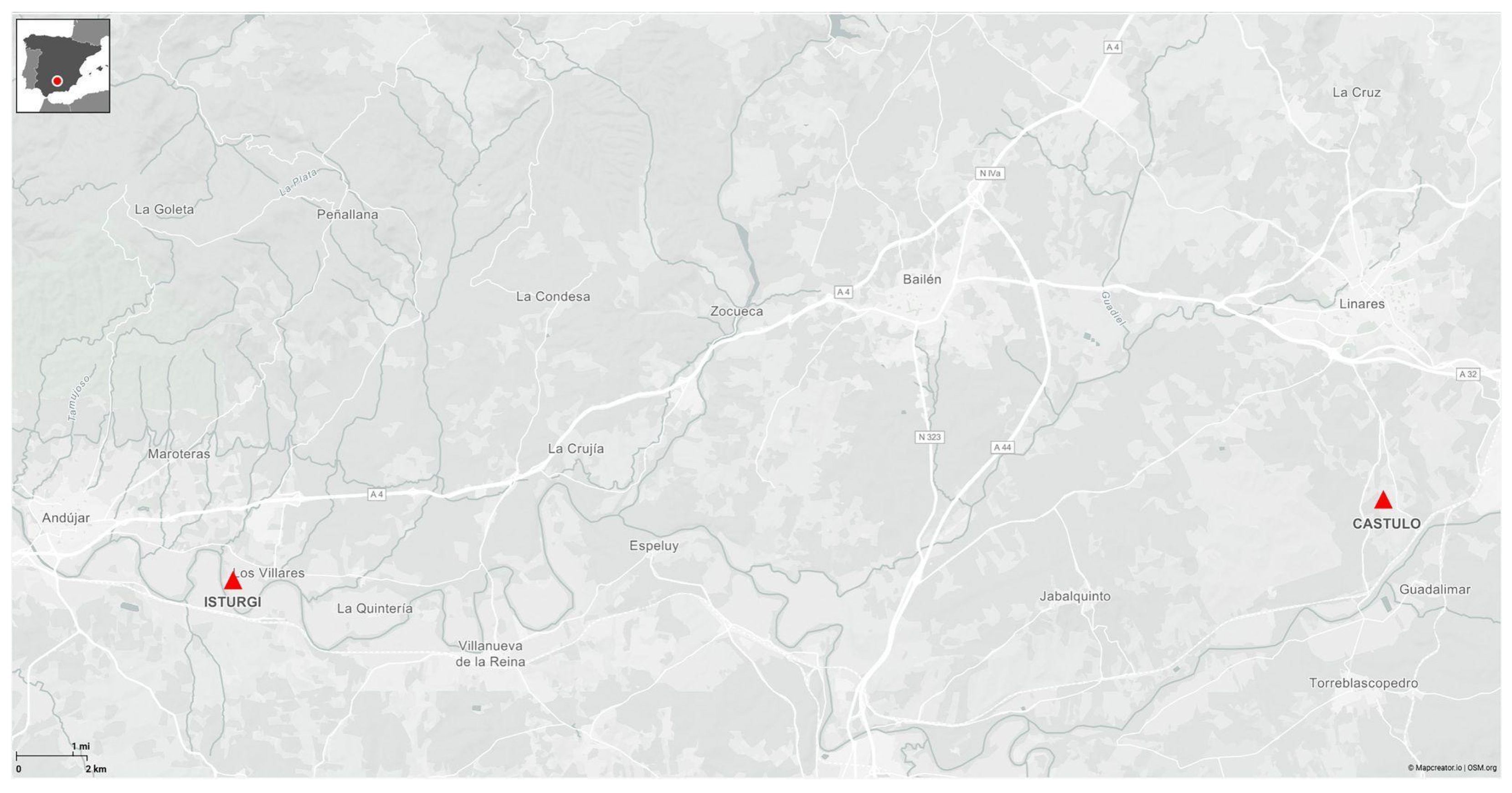
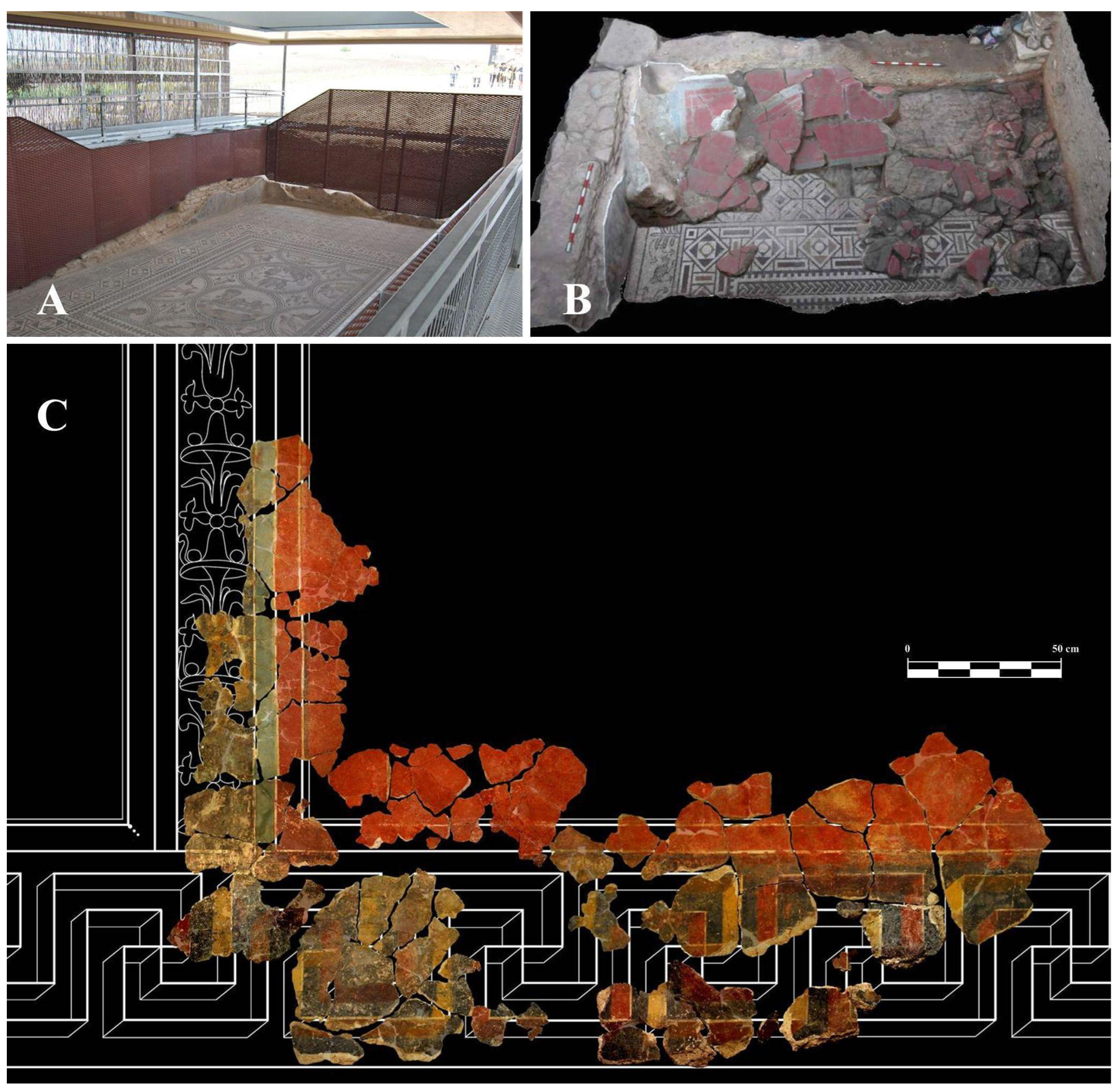
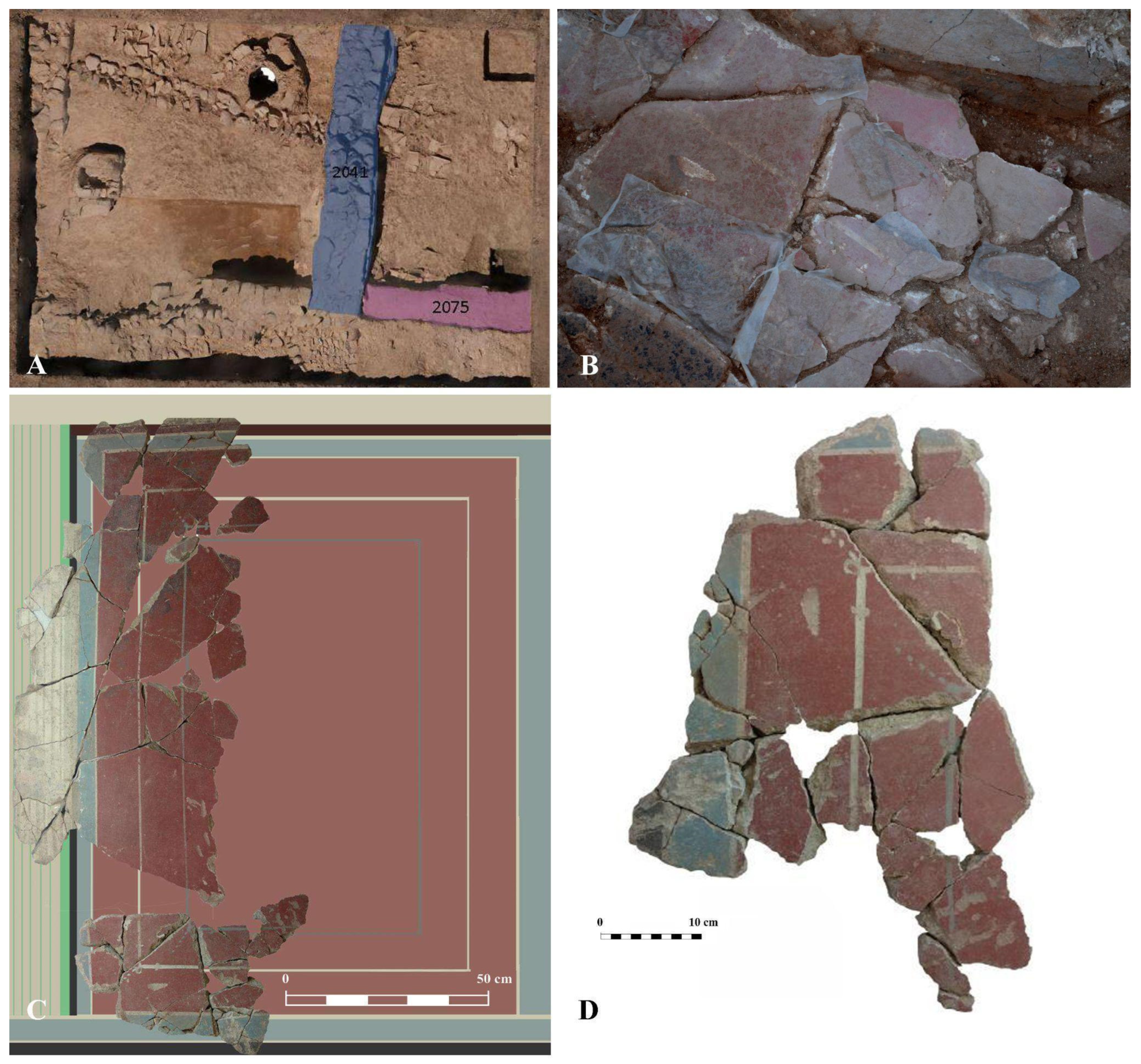
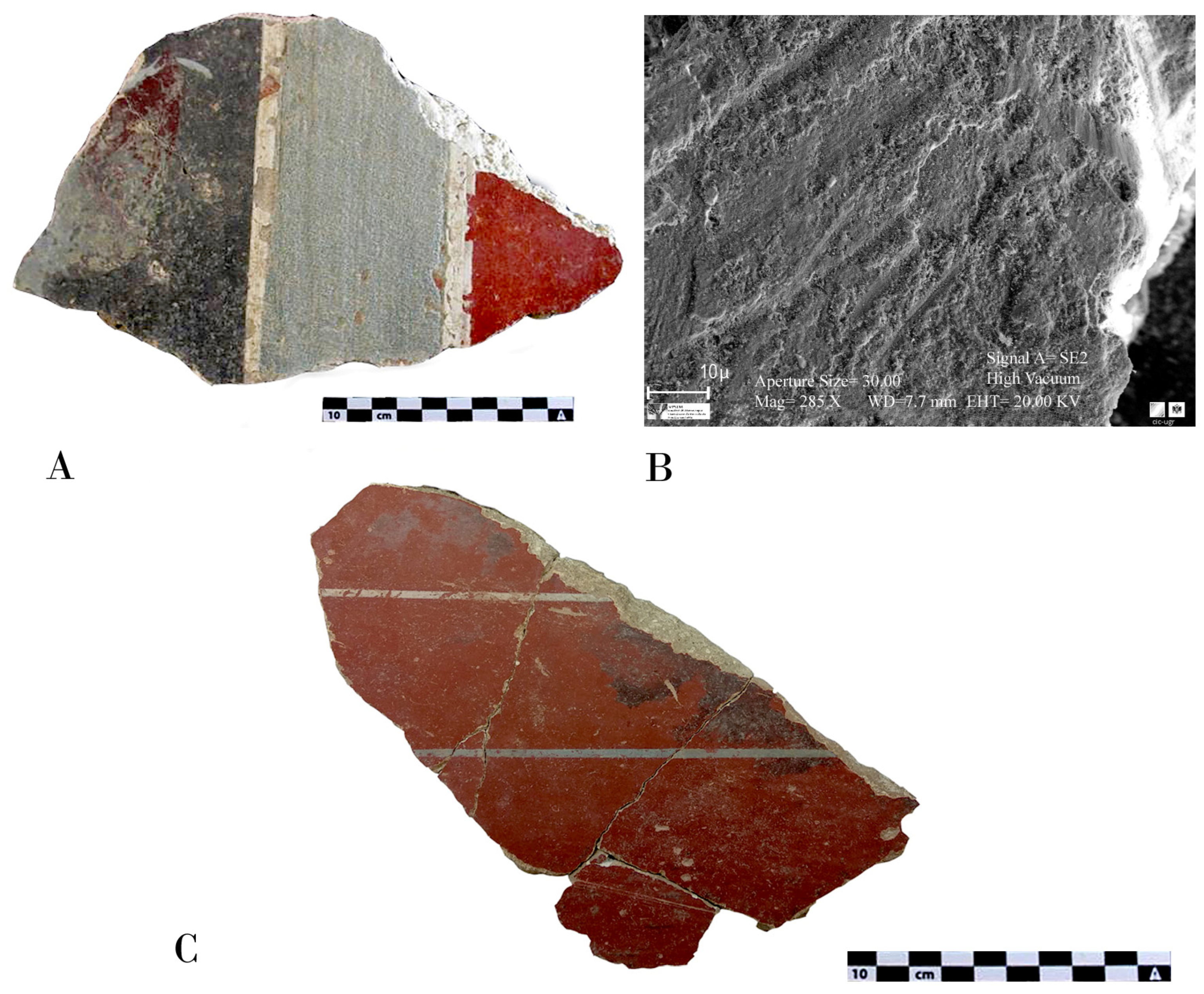

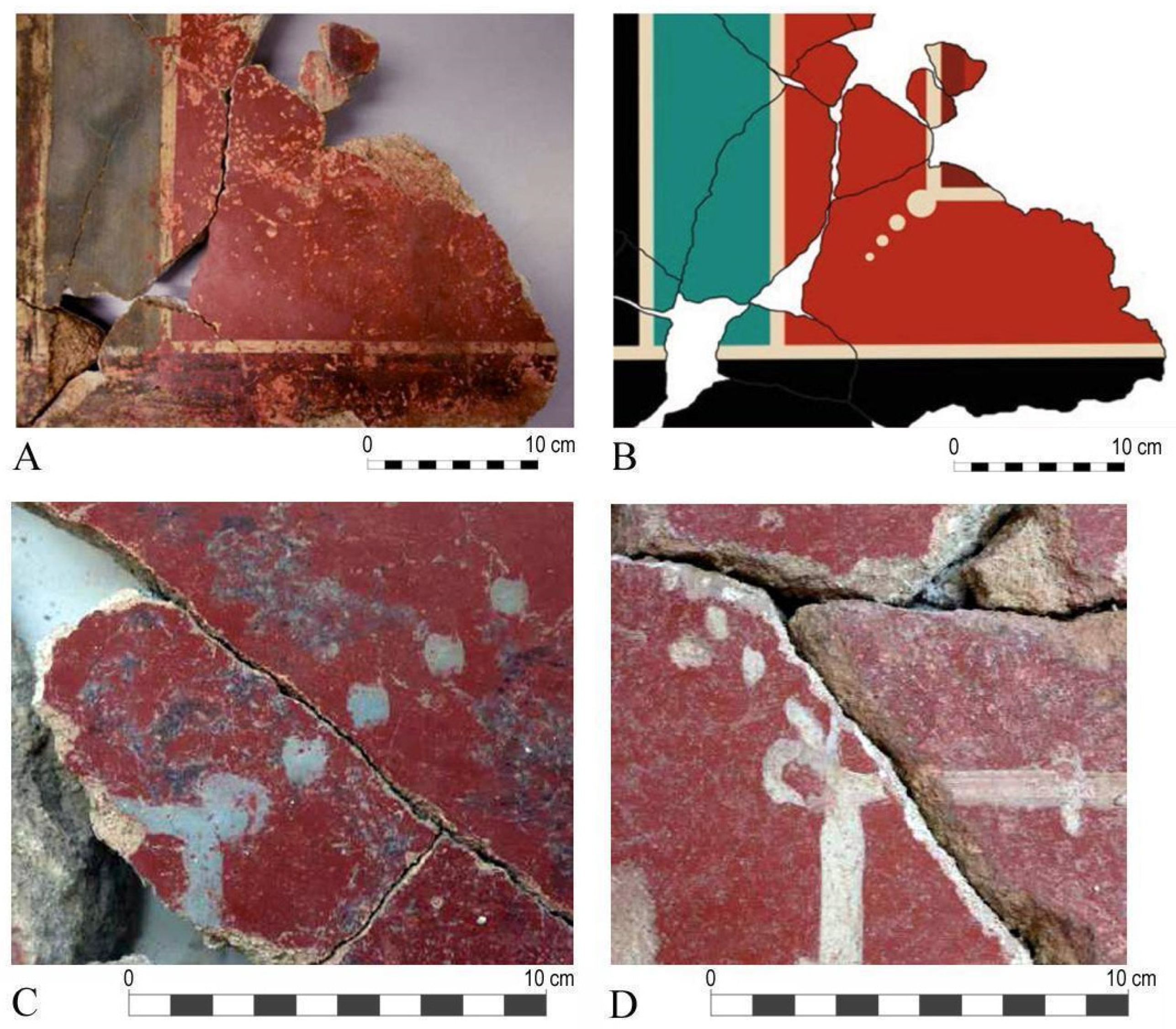
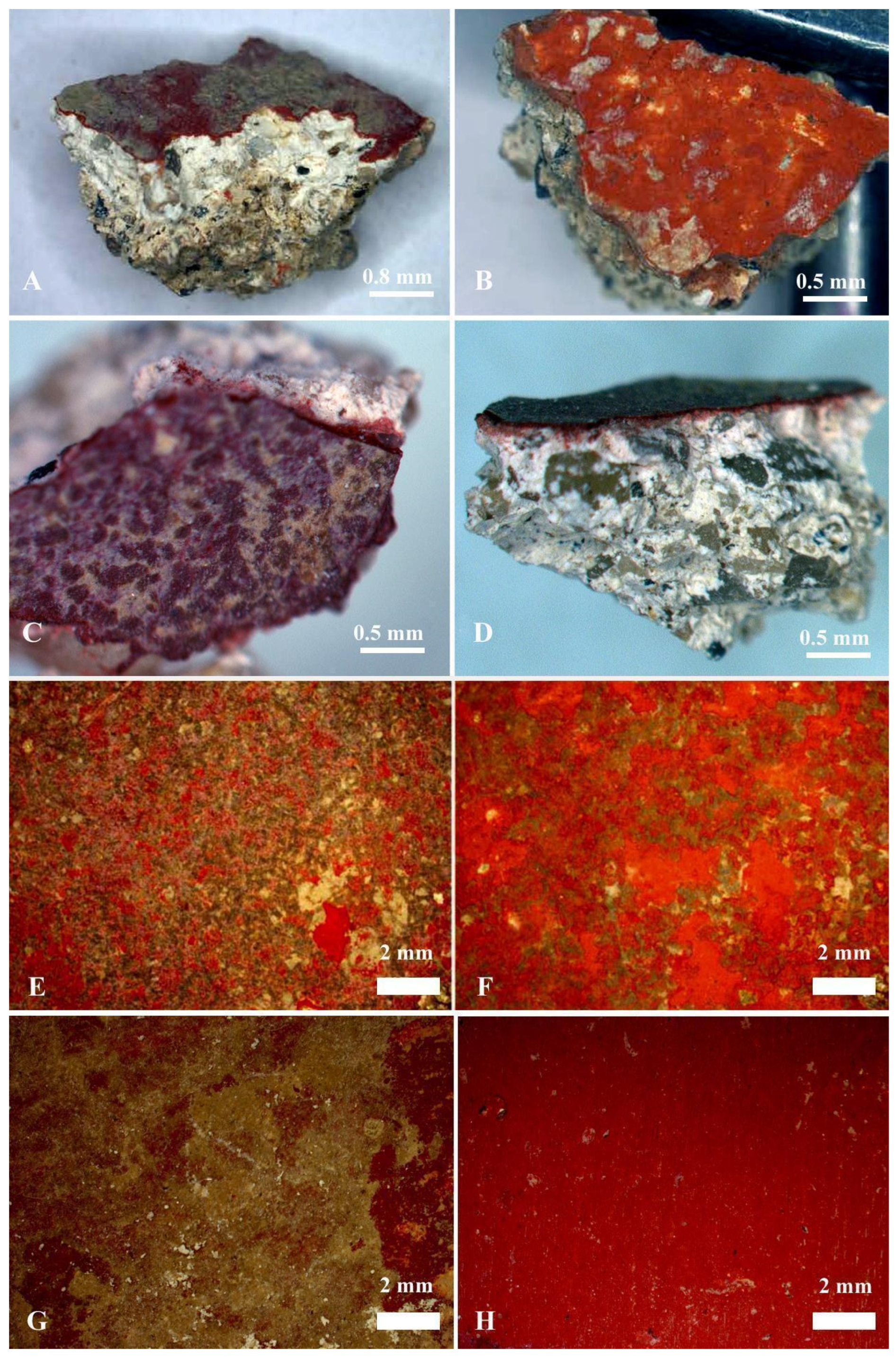
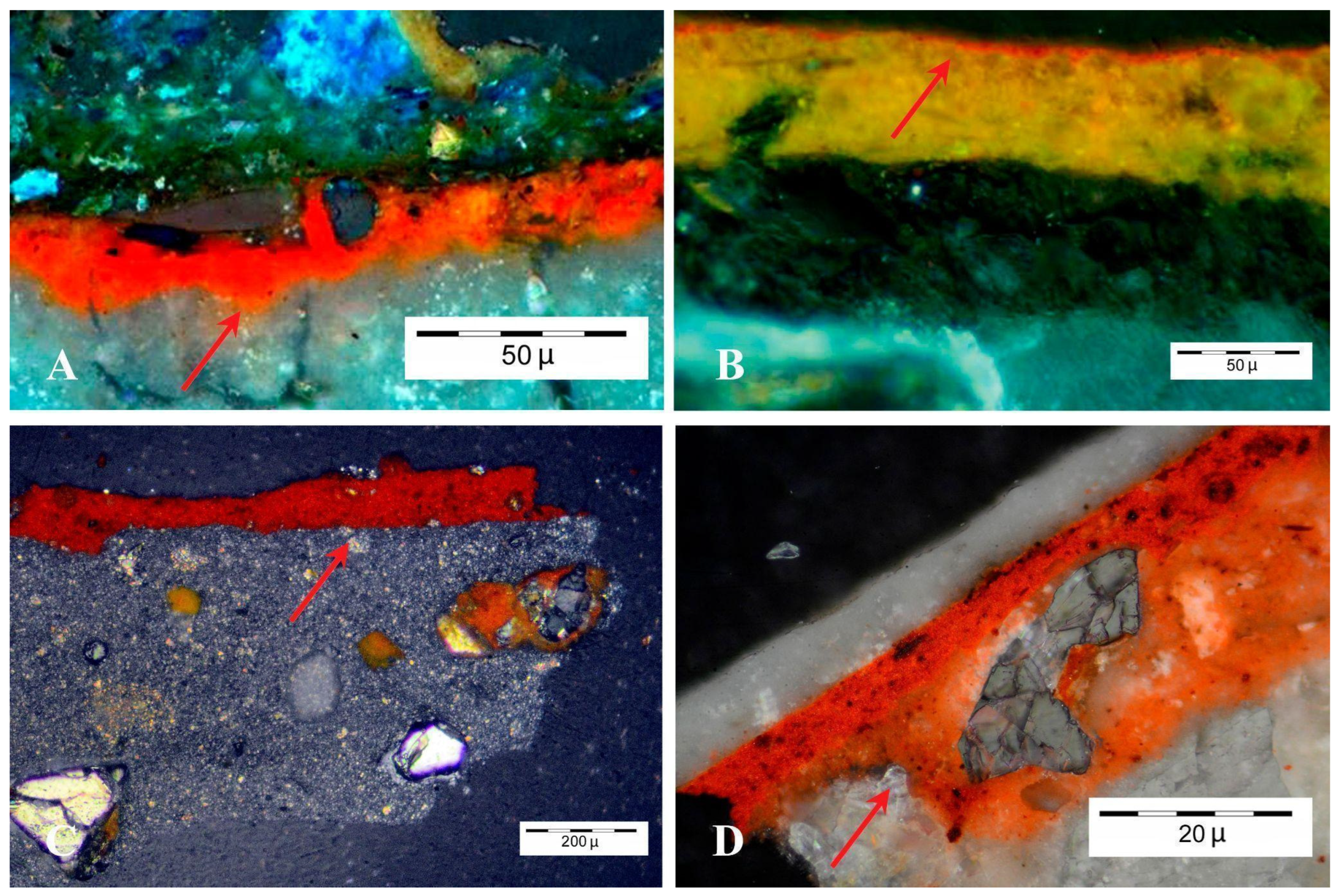
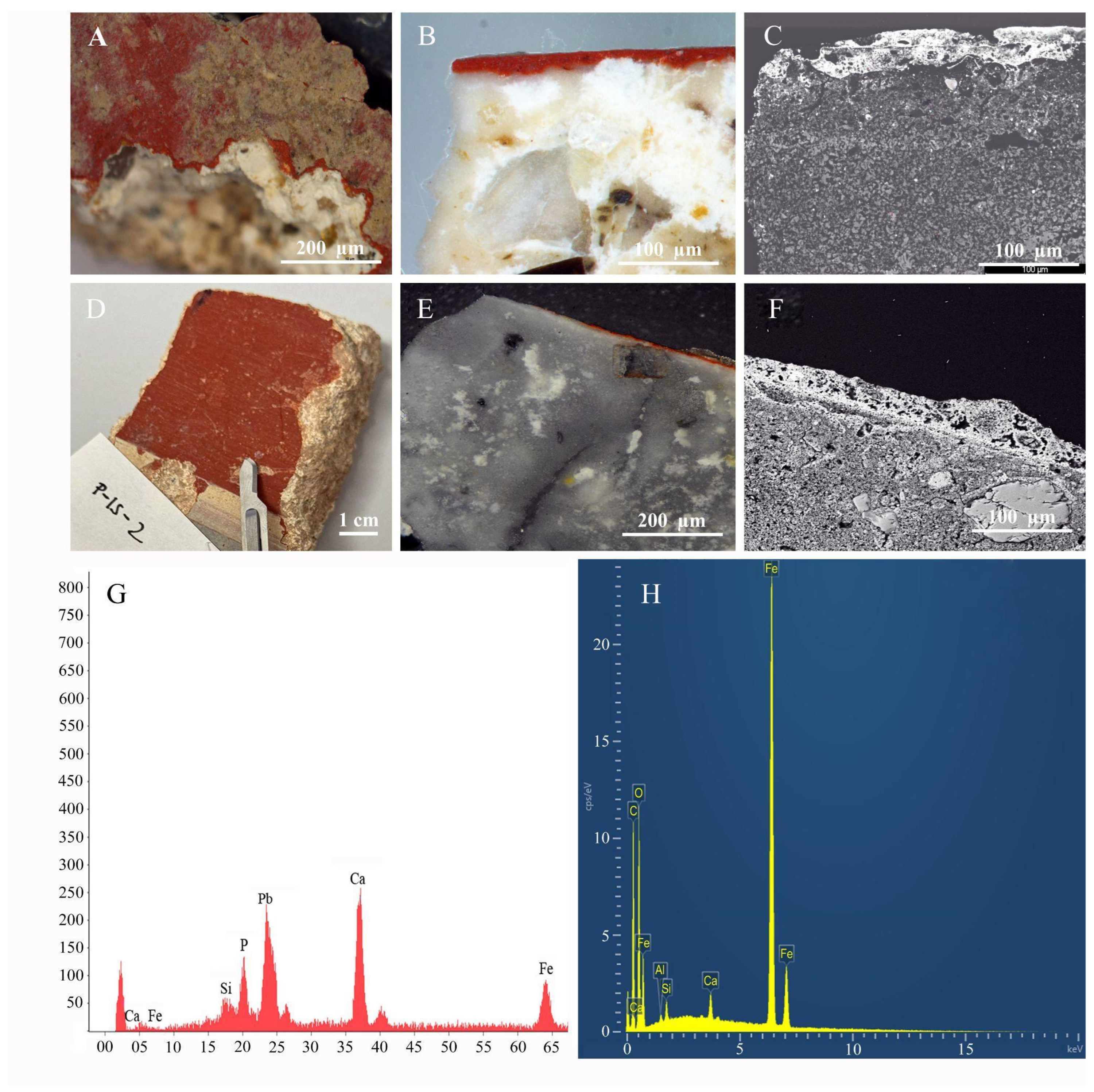

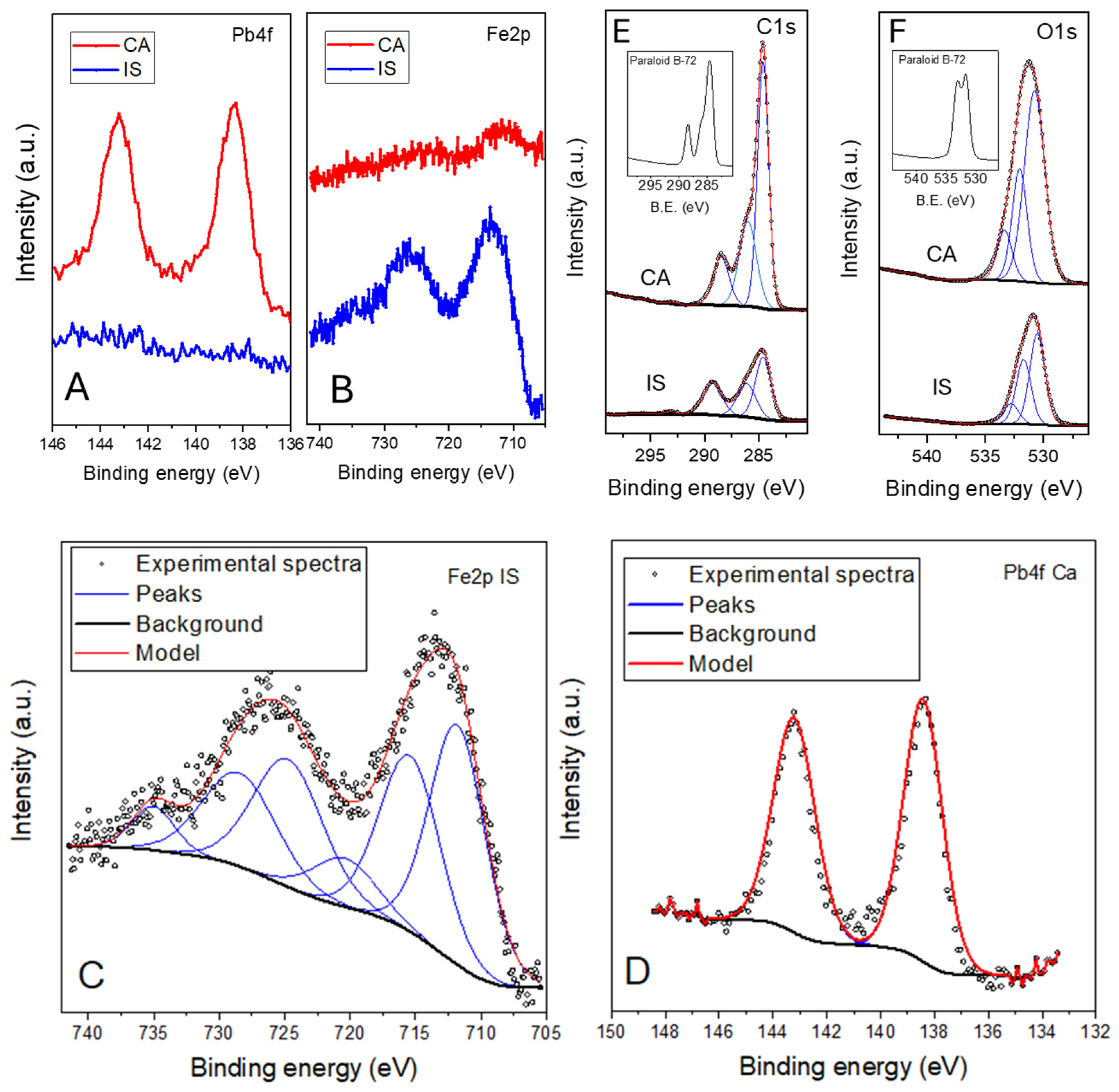
Disclaimer/Publisher’s Note: The statements, opinions and data contained in all publications are solely those of the individual author(s) and contributor(s) and not of MDPI and/or the editor(s). MDPI and/or the editor(s) disclaim responsibility for any injury to people or property resulting from any ideas, methods, instructions or products referred to in the content. |
© 2025 by the authors. Licensee MDPI, Basel, Switzerland. This article is an open access article distributed under the terms and conditions of the Creative Commons Attribution (CC BY) license (https://creativecommons.org/licenses/by/4.0/).
Share and Cite
Calero-Castillo, A.I.; López-Martínez, T.; Calero, M.; Muñoz-Batista, M.J. The Red Backgrounds of Wall Paintings from Isturgi and Cástulo (Jaen, Spain): A Multi-Technique Approach to Understanding and Improving Their State of Conservation. Materials 2025, 18, 1533. https://doi.org/10.3390/ma18071533
Calero-Castillo AI, López-Martínez T, Calero M, Muñoz-Batista MJ. The Red Backgrounds of Wall Paintings from Isturgi and Cástulo (Jaen, Spain): A Multi-Technique Approach to Understanding and Improving Their State of Conservation. Materials. 2025; 18(7):1533. https://doi.org/10.3390/ma18071533
Chicago/Turabian StyleCalero-Castillo, A. I., T. López-Martínez, M. Calero, and M. J. Muñoz-Batista. 2025. "The Red Backgrounds of Wall Paintings from Isturgi and Cástulo (Jaen, Spain): A Multi-Technique Approach to Understanding and Improving Their State of Conservation" Materials 18, no. 7: 1533. https://doi.org/10.3390/ma18071533
APA StyleCalero-Castillo, A. I., López-Martínez, T., Calero, M., & Muñoz-Batista, M. J. (2025). The Red Backgrounds of Wall Paintings from Isturgi and Cástulo (Jaen, Spain): A Multi-Technique Approach to Understanding and Improving Their State of Conservation. Materials, 18(7), 1533. https://doi.org/10.3390/ma18071533










